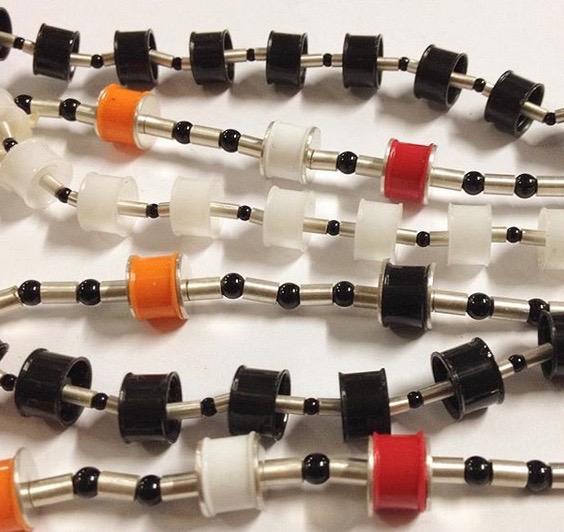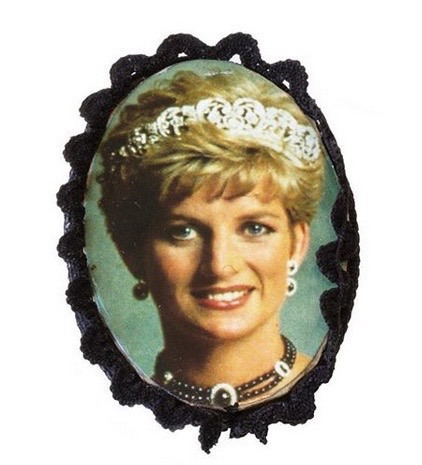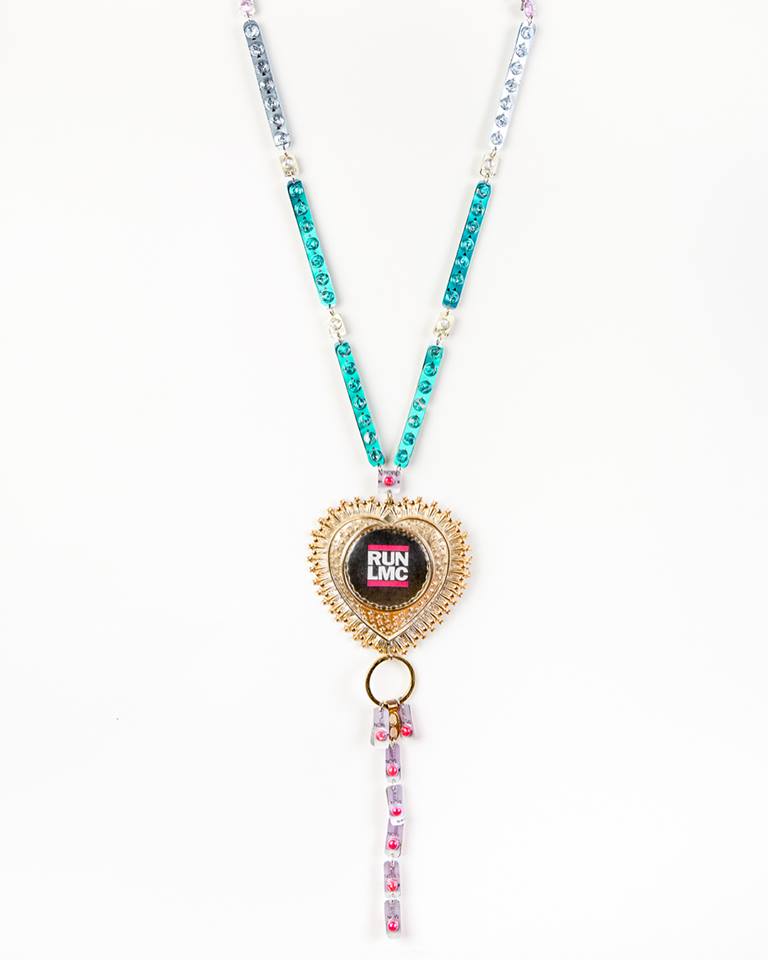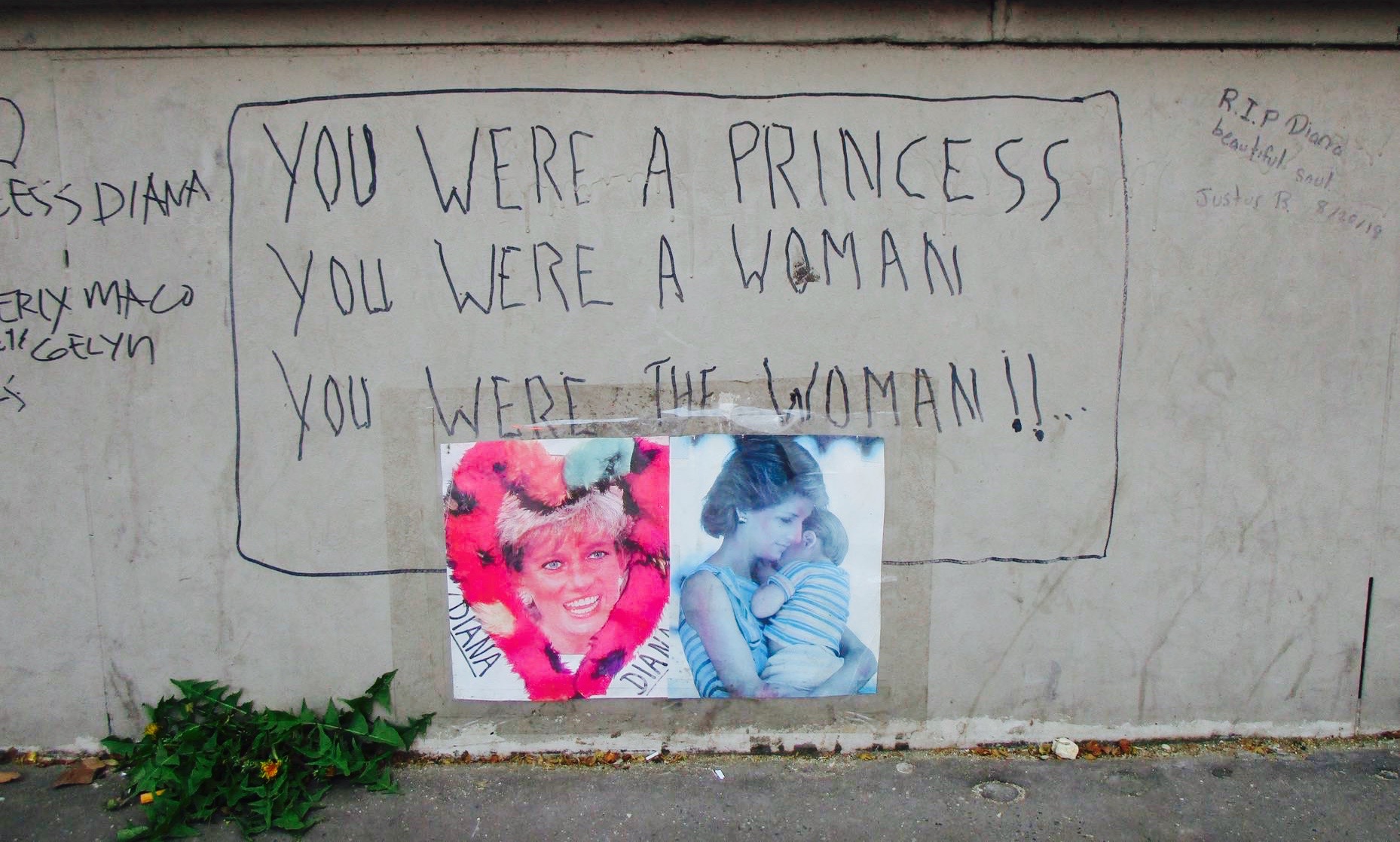
Not long ago, a ‘call to action’ floated across my social feeds. “Gondola. Need one. Anyone selling theirs? Or could help hook a sista up?”
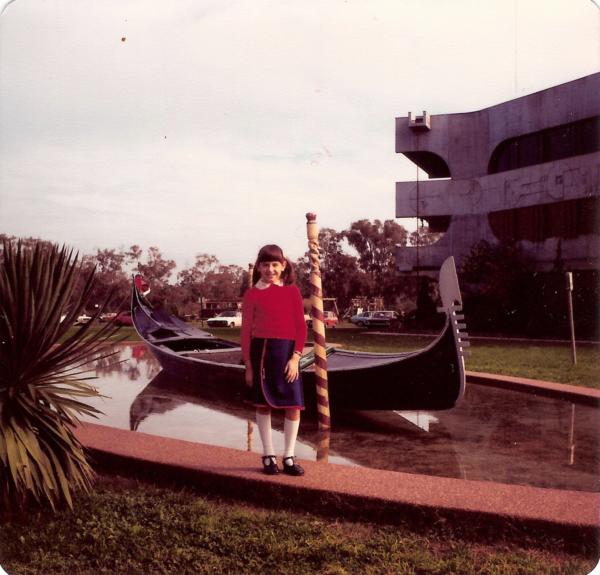
Laila with gondola, 70s. Photo: LMC
It was from Melbourne artist Laila Marie Costa, an old friend of a friend whose art I’ve seriously admired for many years.
Given her line of work it wasn’t unusual. She wasn’t kidding either.
Reaching deep into her Italian heritage and harking the call of refused, obsolete, junk objects – the addiction fever-grip to which she’s been answering her entire artistic life – I intuited she was in the throes of (another) new upcycling project…
While the self-described “creator of art stuff… curator of collections, riffage musician and champion weeder” later told me she “wasn’t exactly sure of exactly what” she wanted to do with said large, “11m long” floating Venetian tub, nonetheless she was “obsessed with the idea of getting a gondola and doing something”.
For this interview she tells me “a year ago” her sights were set on gleaning “shopping trolleys and ironing boards”. Safe to say, Laila Marie Costa – or “Run LMC’ as she is affectionately known – is a hoarder, a collector and a prolific maker using the stuff she prolifically hoards and collects. In her words, art is “therapeutic” – something she also drives home to her art students when she’s teaching.
“You are your history” she tells them, it’s inescapable. True that.
There’s a beautiful kind of method to Laila’s ‘madness’ as anyone who’s clapped eyes on her striking “wearable art” and jewellery can attest.
She’s a deft designer with a raging sense of humour, also bringing to her pieces a palpable sense of consideration and conversation – the kind that comes from not only ‘compulsion’ but discernment and reflection too. Each piece she puts together – whether it be a biggish gondola or a beaded necklace made from miniscule discarded micro-plastics – possesses a distinct political and philosophical viewpoint on the world and how we live in it.
I bloody love it.
* * *
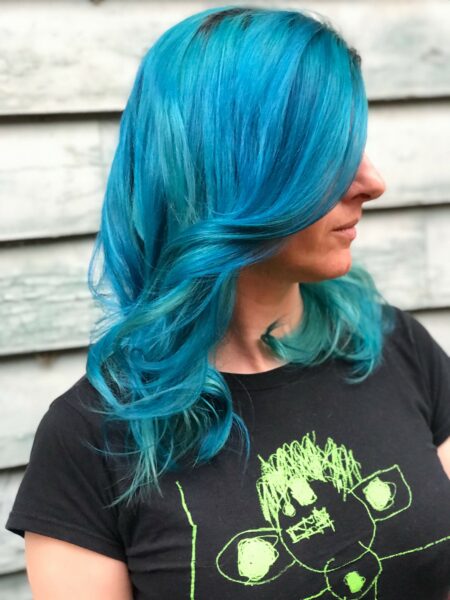
Blue period, 2019. Photo: LMC. Hair by Bam Hair
Laila and I first met in Melbourne in the ‘90s. She was – still is – one of a blisteringly funny, whip-smart and exciting group of individuals, most of them women, embedded in the music, film and art scene of the time, around which I also skirted.
It was popular culture petri dish where craft, art music and politics collided. Then merged.
Anyone who came into contact with it sat up and took notice.
Everyone had their arse hanging out of their pants: we all lived hand-to-mouth and where possible, threw down challenging art. Some of it was mediocre, a lot of it was really good and some of it exceptional, with Laila’s in the last category. I often found myself finding it inside bars or on the walls of friend’s houses.
“Who made that?!” I’d exclaim, simultaneously stunned at its genius, laughing at its wryness and envious I hadn’t thought of it. “Laila,” would come the eye-rolled, smiling answer.
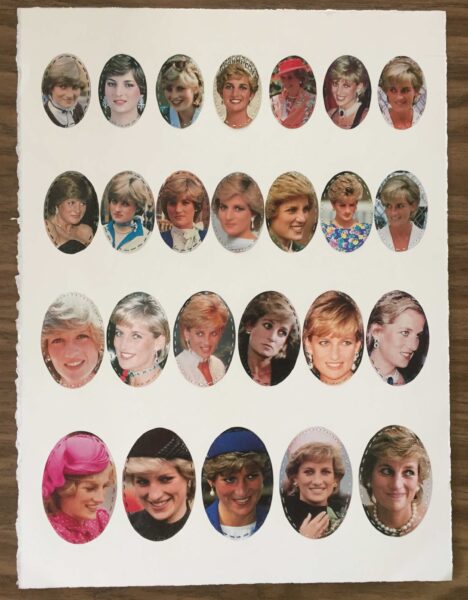
Lady Di, She Died. ‘Untitled, 1998’. Photo: LMC
Last year Laila took the step of co-founding TempContemp, an artist-run gallery and space set up to interrogate, explore and transgress the boundaries of Contemporary Jewellery.
Punk meets Pandora, explode – a “jewellery-ish” space doubtless of which she would have loved to have had the support in her own formative years.
This year she was invited to be part of the 60th anniversary of Munich Jewellery Week, aka Schmuck, “a week dedicated to the most exquisite contemporary jewellery” in the world. We reconnected a few months prior, just as Laila was knee-deep in the “‘Lady Di She Died’ brooch-making frenzy” in the lead up to the Northcity4 Christmas market.
One of Di’s most forlorn faces came across my Insta feed. I pounced. Then invited Laila into the Circus Folk bigtop…
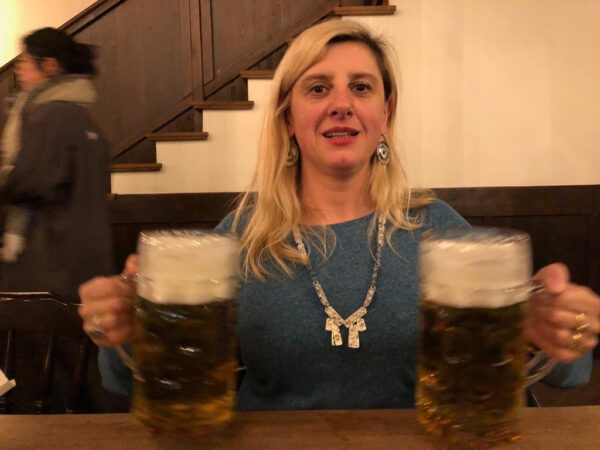
At Augustiner-Keller, Munich, March 2019 for Schmuck. Photo: LMC
CF: Let’s start with your Lady Di brooches – one of which I felt so compelled to buy… Where did you find all of the pictures of her? And what is it about Lady Di that obliged you to make this work?
Laila Marie Costa: I always had a thing for her as a child. Growing up in the eastern suburbs of Melbourne in the 70’s and 80s, she was there! She looked like a beautiful angel with the most beautiful of clothes. I was drawn by the ‘princess’ thing. She was all over Women’s Weekly and Women’s Day. My Mum would buy these [magazines] and I’d pore over the photos. In retrospect, as a first generation immigrant, I think there was something of me ‘projecting’ a desire for ‘whiteness’ and ‘fitting into society’: Lady Di was a perfect example of what a women ‘should’ be.
We also shared the same birth date: July 1. So I also thought we were spiritually linked as Cancerian kin, although our ‘relationship’ did shift as she matured and started exposing her other sides…
I collected the pictures of her as this child living in Bulleen. I’d cut out the pages and save them. Over the years I built up quite a collection. This ‘collecting’ (disease!) has been present forever in my life and is quite vast. It’s borderline O.C.D really. However my mother kind of encouraged it. It was a nice hobby and kept me busy.
I must admit that once friends and colleagues saw the brooches being made a few did donate from their hoards. I tried to use the ones from my childhood – oh! I just remembered, I made a collage about her and the ovals and circles were the ones that didn’t make the cut on paper! So it’s all interconnected.
CF: They’re not just kitsch though: to me they feel like little pieces of recent history – and a still-recent tragedy. How do you view them or feel about them?
LMC: For me they were about telling a story, making an overview of her life – a micro ‘This Is Your Life’ if you will. They are an homage to a woman; mementos of a person, a memento mori really. However, to me, they are a narrative – a broader one about women’s struggle, regardless of class. These objects provide an opportunity to reflect on what ‘could have’ been…
I do see how they are kitsch: I have an Italian background and grew up in a house with doilies and bombomieres, and my Nonni’s house had lots of the religious iconography on the walls. This aesthetic seeps into my art sometimes in the oddest of ways! They are history, moreso a tragic piece of history given the circumstances of her death. I was recently in Paris and went to visit the site of ‘the accident’. It felt a bit stalky and creepy, but I was so compelled…
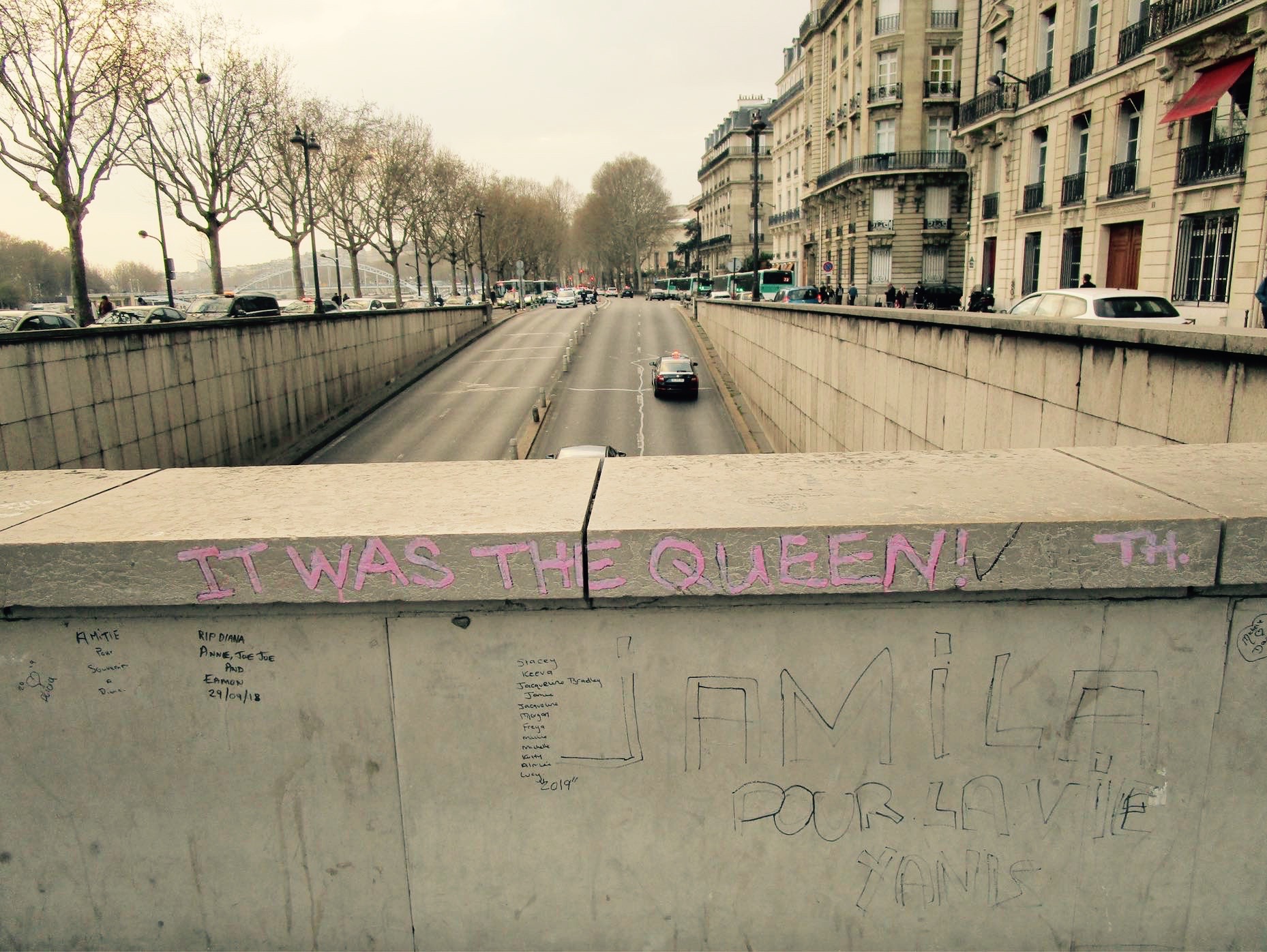
“It was the Queen”, Pont de l’Alma, Paris. Photo: LMC
CF: You’re a prolific creator: a visual artist, a photographer, a jewellery maker, zine maker, curator, musician… Take us back to the beginning: where did this huge interest in ‘making’ come from?
LMC: I’m very multi-disciplinary. Each discipline allows me to express in an exacting way. I like to cross them too and play with the intersections – fortunately “intersectionality” is so very ‘hot’ right now!
I’m a huge collector/hoarder of materials, and I collect forms of expression too. There are so many things I want to say, make, create – and I like that I can mix it up. I couldn’t imagine, for example, solely working in acrylic-on-canvas or photography. It is assemblage within my practice of assemblage…
I’m a product of nature/nurture: I was never really encouraged to be an artist – in fact, it was the opposite. The ‘making things by hand’ started really young, then music, which lead to zine-making, which fed the photography, which became an interest in curation. Ultimately it’s all therapy – something I have to do.
I don’t understand why people think being an artist is ‘cool’. Having talent, being gifted and/or creative is both a gift and a burden, but unfortunately more burden than gift. Navigating this capitalist society in a country that does not support art and culture is also hard work. I’m still examining why I’m such an anomaly in my family!
“No point making something that already exists unless you are going to mess with it” – Laila Marie Costa
CF: So where did you start with “making”?
LMC: The idea of being an artist was a romantic one: I had no idea what it meant. There were no artists in my immediate family or friends. I was always good at art at primary and secondary school and it was one of the few subjects that engaged my brain – art history as well. I got good marks.
First creations I can’t remember apart from the usual school stuff. I did get some paints and a Derwent pencil set ‘from Santa’ and began doing small paintings on paper at home. I was a shy and quiet kid and quite solitary. When I got to secondary school I was introduced to more mediums such as ceramics, printmaking and sculpture, as well as dressmaking and embroidery which were viewed as ‘essential life skills for young ladies’.
My first collection made in earnest – and as a commercial venture – was in the mid-80s when I painted colourful windcheaters and made earrings out of FIMO [soft modelling clay]. They were a bit of a hit and I sold quite a bit via family and friends.
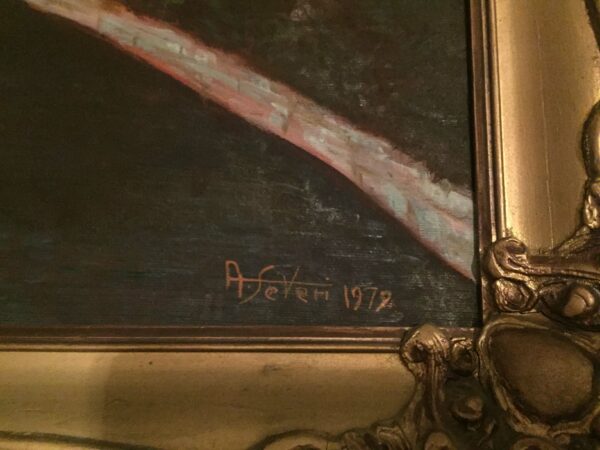
Formative.. A. Severi, 1972. Photo: LMC
I was also taken to a studio of an Italian painter (A. Severi) where my parents bought two originals on canvas. I was quite impressed with the studio but the man was a bit gruff and grumpy – and scary!
He was the first ‘real’ artist I encountered which, in retrospect, was such a traditional European model. I couldn’t work out how artists made a living – I still can’t! Instability scares me.
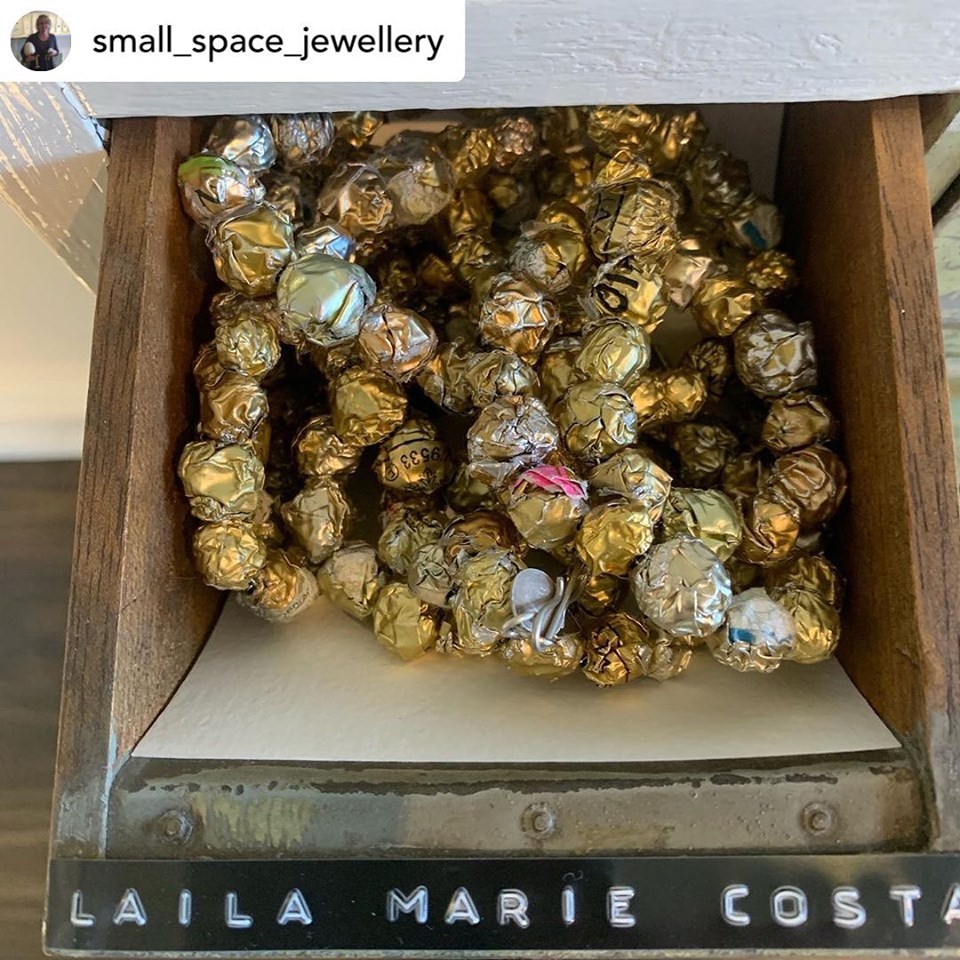
“Golden Necklace”: Laila Marie Costa is ‘In the Drawer’ at Small Space Jewellery. Photo: SSJ
CF: You work with mostly recycled, junk and trash materials. What kind of a relationship do you have with them?
LMC: My work is driven by collecting, mostly materials, sorting them obsessively, arranging and re-arranging, letting the materials ‘talk’ to me about what they might like to be. I have lots of stuff in boxes in the shed and the studio. It’s a big hoard.
Examining my process is like examining the wiring of my brain! “Why is it I need to pick that thing up from the ground, or put that champagne wrapper in my pocket, or bring home a banana box from the ‘stupid market’?! And then why sort and collate, by material, by colour, by species, by some random rule I’ve made up?!” I’ve been doing it for years and years too: boxes full of pill packets, cigarette box papers, empty sugar packets, the innards from empty dental floss containers…
Added to these materials are my interests in social, political and economic values. They get mixed together to become a creation that is more or less ordered. It’s really quite obsessive and controlling. [I’m sure] many philosophers and psychologists would bang on about it being about ‘control over the environment’, so that I feel in control of this random and abstract world of contradictions…
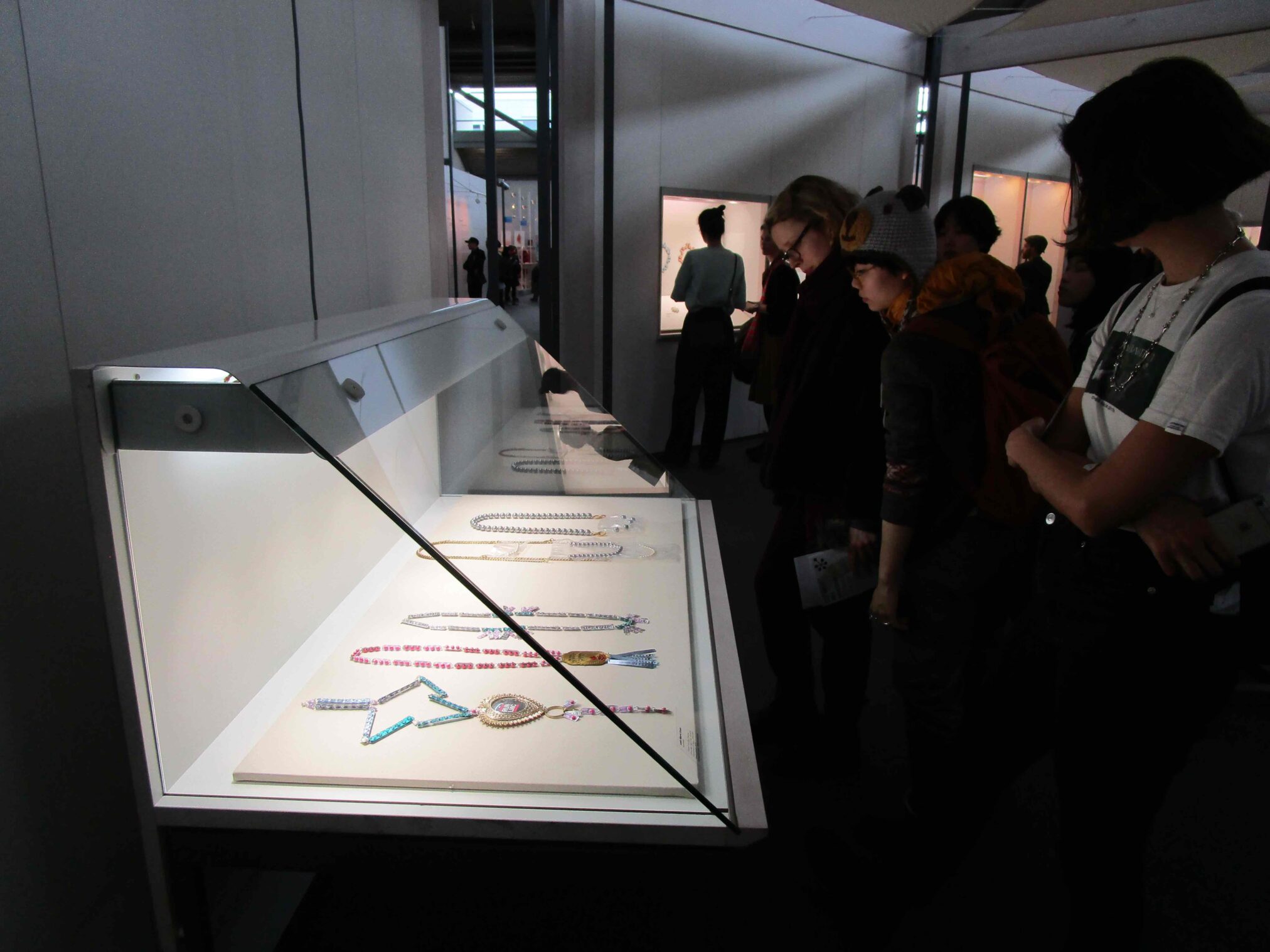
‘Thank You Big Pharma’ necklaces at Schmuck. Photo: LMC
CF: So working with “debris” and “waste” materials: what are some of the most weird or outrageous or mundane things you’ve turned into art? And do you get a kick out of doing it?!
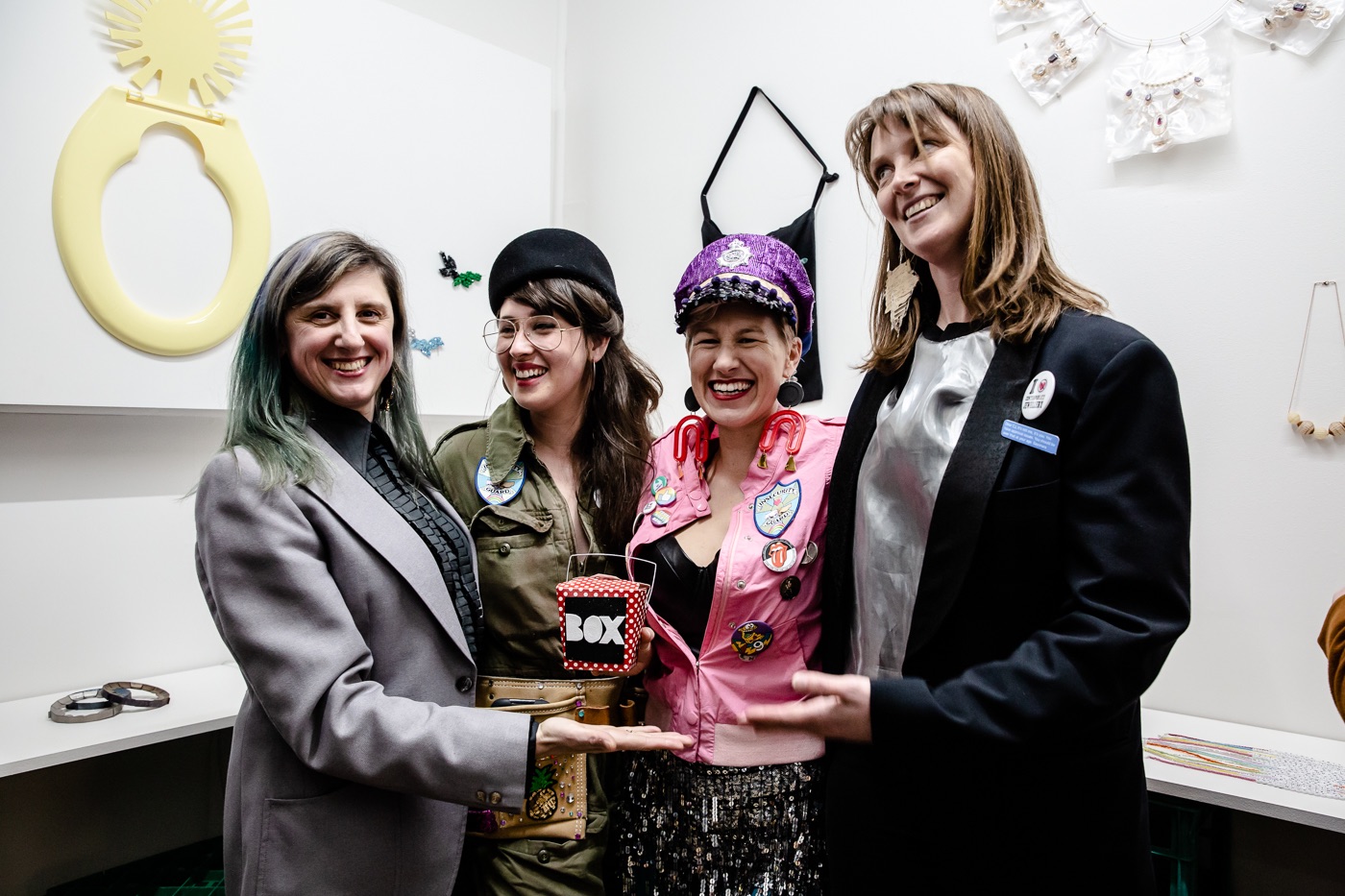
Costa, Insecurity Guards & Anna Gray at the opening of TempContemp in 2018. Photo: Bryony Jackson
LMC: Tampons wrappers (one brand only), hand-stitched onto canvas; my contraceptive blister pill packets have become necklaces… I’m currently in the middle of rolling beads out of the metallic paper on sparkling wine bottles, many hundreds of which I am sorting by colour and size. Lots of old charms – especially crucifixes – which I am having fun messing around with. Always bread bag ties, always sparkling wine cages, always bottle tops, always soy milk tops (one brand only), always stickers on fruits…
Cardboard is starting to get a guernsey – especially fruit and vegetable images. Oh – and the wooden containers French cheese comes in. Ribbons, cord handles from carry bags. Lids from soy sauce fish, under-wires from old bras, trim from old jocks. Bits of broken headlights from cars, swizzle sticks, price tags… It goes on and on.
I’m not sure why I get a kick out of it: making something I’ve never seen done using new materials has been a key driver – and my favourite artists do this. I do get a kick out of the ‘women’s’ products that can offend, and seeing people’s faces as they try work out what’s been used. It looks familiar but in the wrong context. And having a laugh. That’s important.
CF: Is there a particular ‘philosophy’ or ‘approach’ you bring to making jewellery – or “wearable art” – and the other artefacts that you make? Why not just make jewellery the ‘traditional’ way with precious metals and so forth?
LMC: My approach is a very restrained kind of punk philosophy: a “do-it-yourself, have-a-go, make-and-mend, see-what-happens” philosophy.
Sometimes I work from a broader concept, like for example if I want to comment on my ethnicity and being a first generation immigrant. At other times it’s the materials that dictate how something should look. For example, bananas from a cardboard box are going to be earrings because of their size, shape and curves. A larger banana will be a pendant.
Art history informs all that I do. “You are your history” is my mantra, something I used to bang on about when I taught at Art and Design. [There’s] no point making something that already exists unless you are going to mess with it.
Traditional materials of metals and gemstones are costly and [things] I cannot really afford, given I am a low-income earner. I’d love to seriously play with yellow gold and large diamonds, rubies and sapphires, but that’s just not going to happen (at this point anyway!) [One day] I will make something out of silver and blue topaz, but I can see the 18ct yellow gold and ruby version in my head.
And some [precious stones] go with other materials, like cheap wire. I worked as a gallery consultant for several years so have a solid knowledge of diamonds and the four ‘Cs” when buying one – the cut, clarity, colour and carat. I’d be more than happy if a patron wanted to indulge my visions for high-end jewellery!
“You are your history” – Laila Marie Costa
Then there’s sustainability and the environment to think about: why keep digging this stuff out of the ground (and on whose ground?) when you can harvest from the millions of tons of waste we humans make here? I’d love to harvest gold and silver from e-waste, especially dirty mobile phones and laptops. There’s’ so much metal in there!
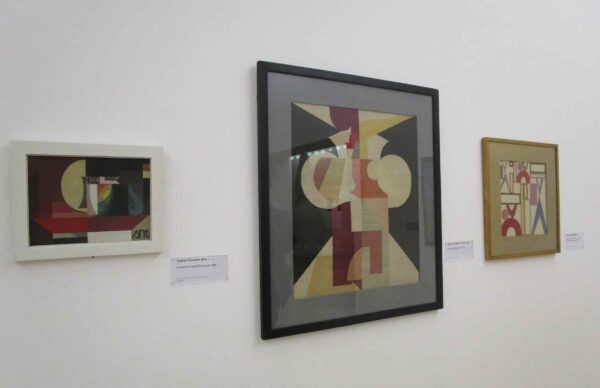
Sophie Tauber-Arp at the Pompidou Centre, Paris. Photo: LMC
CF: Do you have ‘art heroes’? Who or what inspires your personal art practice?
LMC: Many [people] inspire me, from contemporary jewellers and painters to writers and musicians. They change constantly too as I glean bits from the practice of others. I may not even like their work but there will be something in there that sings to me.
There are so many, but just to name a few: Old School: Annie Albers, Sonia Delany, Lucio Fontana, Manet, Monet, Sophie Tauber-Arp; the Bauhaus women, Tiepolo, Paladio and Bruno Munari. New Skool: Al Anatsui, Joanna Vasconcelos, Lisa Walker, current work by students Space Invader and Eugene Carchesio. Or often it will be something I see on my travels around Melbourne – like stuck on a pole, or from some of the art made by the people I meet in my community art work.
CF: What are some of the “day jobs” you’ve had – best and worst? And how do you handle that ever-challenging conundrum of balancing between the two?
LMC: The balance is, well, never well balanced! There is always too much ‘working for the man’ or not enough time to make. At the moment I’m in a state of creative outpouring after many months of working on other artists’ projects. But there are still not enough quality hours in a bout of making.
At the moment I’m a project manager and curator for the Urban Campfires community art program and exhibition for the Neighbourhood Justice Centre in Collingwood. This is a unique program of community engagement with the Centre that is a magistrate’s court. It is the only magistrate’s court in Australia based on a community justice model. It’s progressive, innovative and supports social justice for minorities. I recently started as a mentor for a mentee via Arts Access Victoria and her NDIS plan.
That’s the ‘paying stuff’. Then there’s my personal practice based at NorthCity4 in Brunswick and co-directing TempContemp gallery there with my partner in curatorial crimes, Anna Gray. It’s been running for over a year and has garnered huge response, especially from the overseas artists.
We do a lot of collaborating in the TemContemp gallery: we collab on curatorial premises, promo, curation, installation and catalogue design. She is the ‘good cop’ to my ‘bad cop’ (or is it the other way around?!) It swings, but we have a wonderful dynamic that allows for some edgy and non-conformist outcomes.
I’m in a band too so there’s practicing, rehearsals and gigs to do… I’ve had so many jobs that I couldn’t even count them. Working at The Tote Hotel in Collingwood was a memorable time, albeit hard graft and late nights. I taught at Swinburne TAFE for 10 years. House cleaner. Nanny. Preservation technician at the State Library of Victoria. Waitress. Curator for the Shepparton Court art collection. Gallery consultant at Studio Ingot, Fitzroy. Customer service at McDonalds was my first official job.
All have their good and bad moments though I wouldn’t want to work behind a bar again. The sore feet, shift work and getting very grumpy – so not much tolerance for unruly punters!
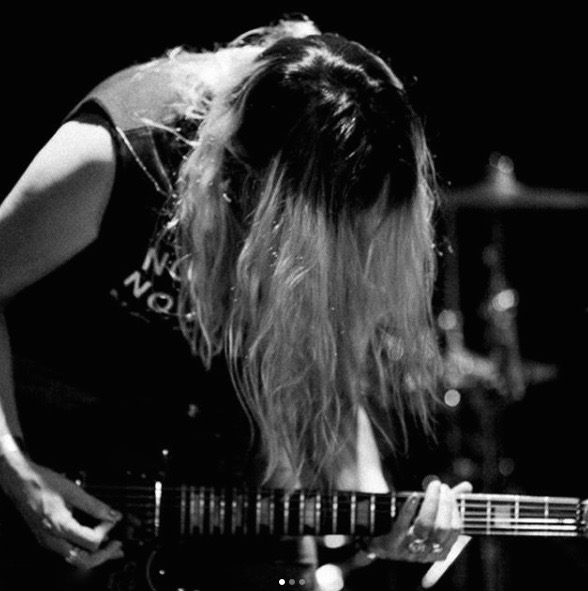
Study for Laila and bass. Photo: Nat Recalcitrant Photography
CF: You seem to be part of a pretty vibrant arts and music community in Melbourne. Do you prefer to work alone or collaborate?
LMC: I’m an extroverted introvert so I like to be around others working but not necessarily in ‘the thick of it. I’ll always be on the fringes of the group/community. I’m not an ‘alpha’ or a ‘beta’ either: I find that if I work solo at home for days on end my head goes to bad places. So I need to keep the mental health up by being around others and engaging.
CF: That said, being an artist or a creative worker in Melbourne – which I was for many years too! – while there is a sense of community it can also be pretty cliquey! What’s important to you as an artist? And what keeps you going?
LMC: Yeah, Melbourne is vibrant with loads of events and festivals on all the time – it’s quite overwhelming really! And yes, with this is a cliquey-ness, which I try to avoid or manage. I’m not in the ‘cool kids’ cliché and never have been. I can see how this has limited my achievements by not drinking at the bar with the right people, networking at openings etc. I’m just not good at it and not really interested in talking about myself and my practice all the time.
I am however fascinated to watch who has the power and how it gets interacted with – observing the ‘push and pull’ of a gallery full of various industry players.
As I mentioned before I’m not a leader, so I like to be with other creatives, but around the margins of a group. I’ve also got to watch where my energies go so I need to pull back at times from over-committing. What keeps me going is the need to keep making and thinking creatively. It’s odd to think my life can be absorbed for hours arranging and rearranging bits of rubbish. All art is therapy and that’s why I have to keep moving! I don’t like to think on it too much…
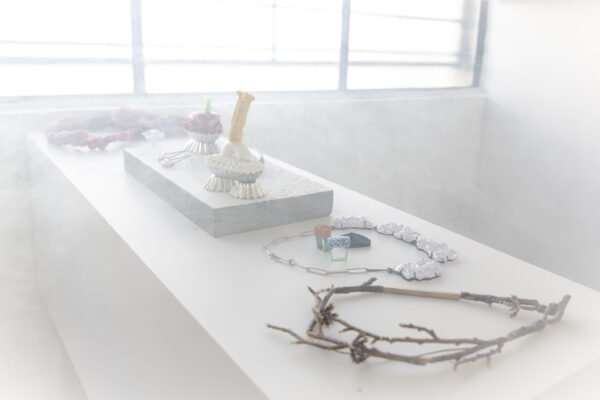
In situ at TempContemp with smoke machine. Photo: Bryony Jackson
CF: What are some of the most memorable exhibitions your work has featured in over the years?
LMC: I had some zines in an exhibition at the State Library of Victoria in 2017: ‘Self-made: Zines and Artist Books’, which is now touring around Victoria for two years. I like the idea that it’s going to rural cities to ‘spread the love’ us city folk often take for granted!
I think Schmuck in Munich earlier this year (2019) has been the highlight so far. Perhaps the last one is always the most memorable as your head is still in that space. Schmuck exhibition is a large international exhibition that occurs every year. This year was its 60th year running. I applied, submitted and was accepted! There were 762 applicants from 52 countries and 65 made that short list. I never imagined for a second I would make the cut.
[For me], by applying, it was a bit of [conforming] to the system. But then I got accepted! So I have become part of the problem – not part of the solution! But I was so very excited to be selected by [curator] Dr. Sabine Runde, and so glad her definition of jewellery aligned with my work. My partner and I did go to Schmuck to be part of the 5-day festival and be ‘schmuck-ed out’ by the amount of jewellery on exhibition.
The section of the exhibition I was in went on to be part of a larger jewellery festival in which there were over 100 exhibitions by artists from around the world. It was a wonderful opportunity to schmooze with international artists, teachers, curators and punters.
Over the years I have exhibited overseas and will soon be in group exhibitions in Porto, Portugal, and Arnhem, The Netherlands, in October and November 2019.
CF: And you curated a show for the 2019 ClimeArte Festival in Melbourne – what kind of conversation is this festival interested in having with its audience?
LMC: For ClimARTe I curated a group exhibition called ‘The Urban Gleaner & The Plastique, Pt. II’, which included work by five artists from Australia, New Zealand, Sweden and Brussels. (It follows up ‘The Plastique Pt. I’ from 2016). The artists used a majority of recycled/repurposed/collected materials. As a curatorial premise I’m interested in the way contemporary makers increasingly engage with these materials and how far they can push them.
Part of my conceptual basis includes issues of sustainability and environmentalism. It is a political stance that comments on my other personal issues as a female, first generation immigrant and my class. Supporting festivals like ClimARTe is perfectly aligned with my beliefs, as is the Sustainable Living Festival which I’ve also been part of in past years. These festivals question and challenge how we live in this capitalist system of G.D.P and increasing population – and the big ‘CC’: Climate Change. I don’t live in a lefty bubble of chardonnays, soy lattes and hipster tree huggers. [But I do know that] humans can be very odd creatures…
CF: You took ‘the big leap’ by co-founding your own gallery in 2018, TempContemp in the Northcity4 in Brunswick, Melbourne. Why – and what do you hope to achieve with it? (It must be a lot of work!)
LMC: I co-founded and co-direct TempContemp with my partner in curatorial crimes, Anna Gray. We launched the first exhibition in August 2018 and just over a year on we have curated four exhibitions with opening night parties complete with live bands and beats, an old skool zine catalogue for each, and have been assisted by four volunteers who have helped with the heavy lifting, tiresome socials and general motivation.
We received two grants from the Moreland City Council – arts investment grants – which meant we could actually build a space with lighting and other bits and pieces. It was set up as an experimental space: a white cube run by artists for artists, allowing for a platform to exhibit contemporary jewellery without the pressure of ‘having’ to sell.
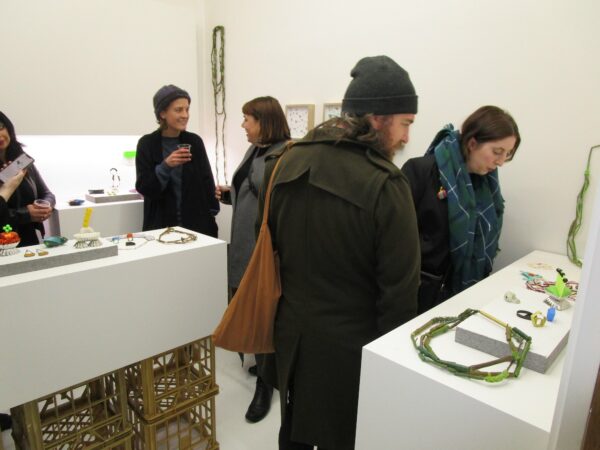
Opening, ‘Urban Gleaner & The Plastique, Pt.II‘. Photo: LMC
Most artists stock jewellery with galleries which have a heavy emphasis on selling, therefore there’s not much ‘real estate’ in which to get playful, explore options and push the boundaries of what jewellery can be.
For example, jewellery can be video, dance, music, installation or participatory. This is the kind of art that drives Anna and I to keep delving into what is going on in studios all around the world.
Jewellery is an art form – it is a fine art form – and it is coming to a contemporary gallery near you! We want to educate the wider public as well as advocate for more jewellery in more galleries. It is already happening!
After a year of the pilot program – burnt out and reflective – it’s been a wild ride. We will be continuing in an altered form, we’re just not sure what that form looks like yet. It will involve exhibitions at the gallery but could include loads of other things. The appetite is out there – especially from the international artists – but we do need funding to keep going.
CF: So you’re one busy poppet! What do you do for ‘downtime’ – is there such a thing in your world?!
LMC: Downtime does exist, although in short fits and starts. It includes cups of tea and reading from actual analogue books (though that tends to be work-related too!), weeding and sweeping in our suburban garden. I’m a champion at it – I find it resets my brain. I play in a band too – but I’m not sure if that’s work, downtime, or somewhere between the two!
I never get enough downtime – or sleep, one of my favourite things to do. I’m really good at it…
Many thanks to Laila for the interview! Stay tuned for the gondola update…
* * *
- Interview: Laila Marie Costa
- Photos: by or courtesy of Laila Marie Costa (unless otherwise credited)
- Words/edit: Megan Spencer
- Visit: Laila’s website and view her portfolio
- Follow: Laila (@LazyLiberty) on Instagram
- Like: TempContemp on Facebook
- More: about Schmuck in Munich
- More: about Urban Campfires art program and ClimeArte

